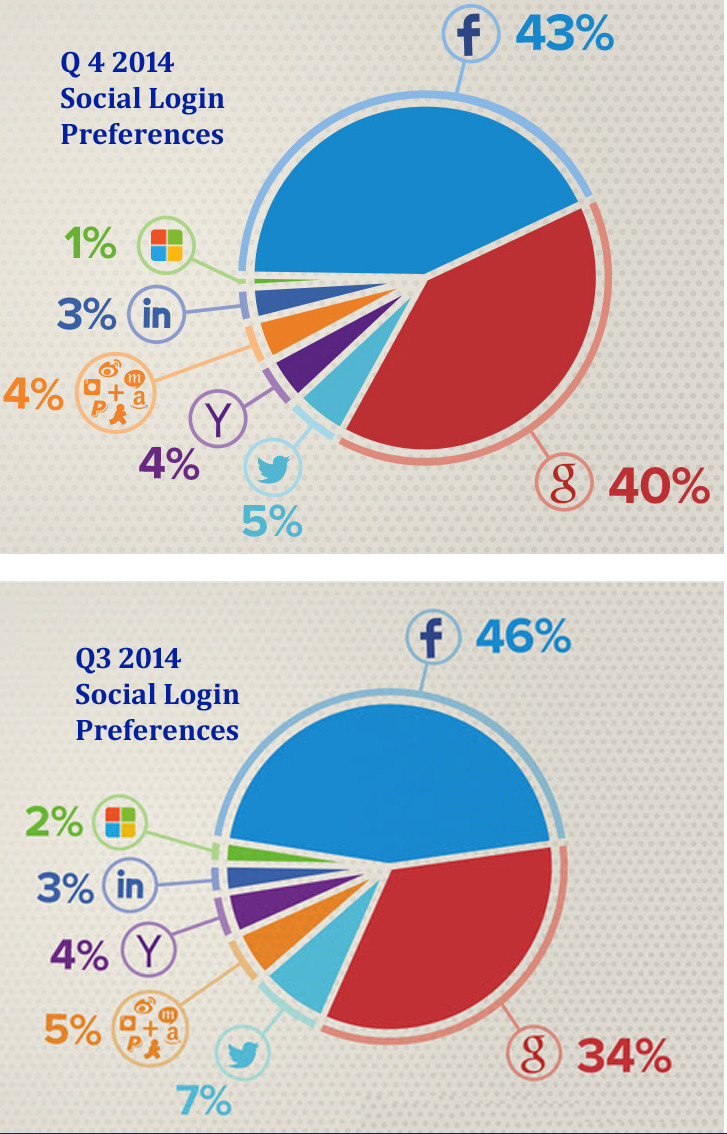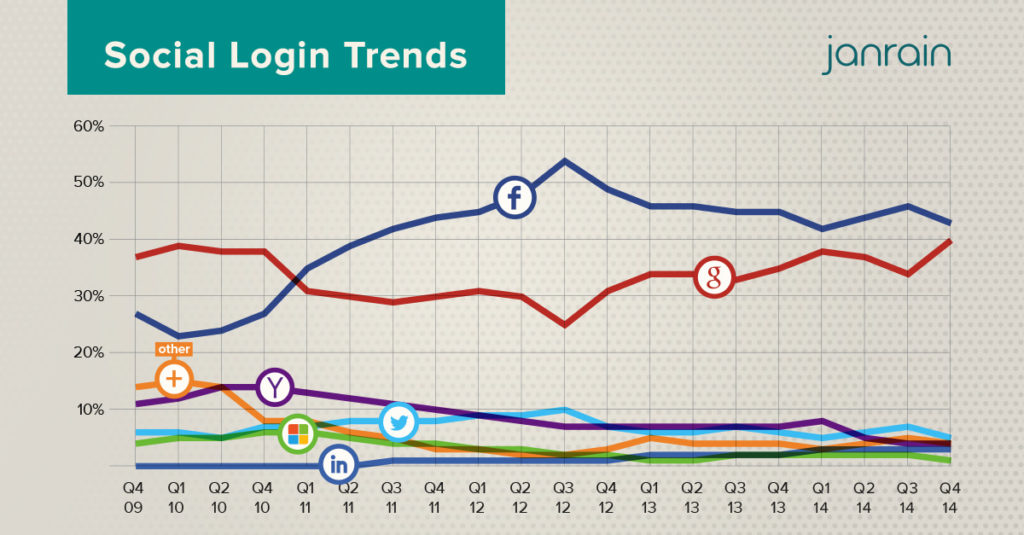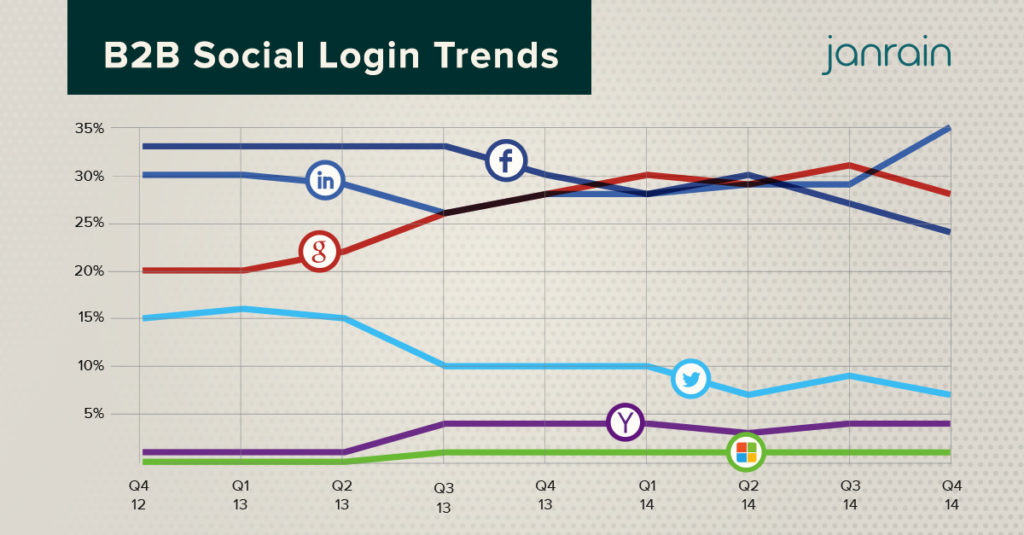Social sites are no more just a platform for getting in touch with family and friends or to interact with acquaintances. They have, in addition to the above, come to be known as opportunities for business owners for improving their online presence.
Most website owners have now started using social logins and social sites to enhance their online presence and it would, undoubtedly, benefit them immensely if they could understand user preferences for signing in to their sites. Understanding which of the umpteen social sites host the most logins can help marketers and website owners the chance to optimize their online presence.
With this in mind, Janrain, a leader in social tools industry, conducted a study to find out how effective social logins are for personalizing digital interactions. The agency has just released its social login trend report for the last quarter of the year 2014. While Facebook Inc. (NASDAQ:FB) continues to account for more social logins in Q4 2014 (in keeping with the past trends), the gap between the leading social site and its closest rival Google+ has narrowed down significantly and now they are only 3% apart as compared to the 12% during Q3 2014. Interestingly, four out of five social login sessions are powered by either Facebook or Google+, therefore a brand must allow its users to login via these two social networks along with standard registration-login form. However, in B2B segment, LinkedIn is still holding its dominant position with 35% of total social login share, followed by Google+ and Facebook.
In spite of apprehensions about security and privacy related to social logins being raised by various quarters, it facilitates the process of logging into websites for users due to which it continues to have a string adoption, the misplaced fears notwithstanding. In fact, nearly 50% of the consumers, who require login to the site for various purposes, were found to be using the social login option in October 2013. And why not- since it does away with the tedious task of remembering the username, email id and password associated with each of the websites that an active surfer likes to visit, signing in through a reliable social site seems much easier.
Though wary about sharing too much information about himself over the internet and watchful about the possible places any site owner could use the data thus shared by them while granting permissions to any website or app, they only want to safeguard their privacy while exercising this caution. Janrain has found out that 77% of the consumers prefer to login to websites through their social sites rather than opting for the traditional registration process.
64% of the people surveyed by Janrain during the course of another survey said that social login option must be offered as a solution for the problems posed by forgotten email id, password and other information. Not only this, more than 90% of those signing in to their most sued websites through their social networks were satisfied with their experience.
Social Login Share of Various Sites for Q4 2014
After studying the social login pattern for Q4 2014, this is what Janrain observed:
- Facebook continues to be the most preferred social site for affecting a social login. 43% of the social logins during the three month period ending Dec 31 were through Facebook. Could that have anything to do with the site having the biggest user base among all networking sites?
- Google Inc. (NASDAQ:GOOGL) owned network, Google Plus might not be the most popular site for interacting online but it commands huge respect. The very fact that the search giant Google is behind it, lends a lot of credibility to this network which accounted for as many as 40% of the social logins during Q4.
- While the two aforementioned networks emerged as clear leaders, the micro-blogging platform Twitter was placed a distant third. It accounted for only 5% social logins during the period being studied.
- Only 4% people were seen to sign in to websites using their Yahoo account, placing it on a miserable fourth place.
- LinkedIn with a very sorry looking 3% share of social logins was placed at the No. 5 slot.
- Amazon, PayPal and Instagram together accounted for only 4% o the social logins.
The overall trends are well reflected here:
Q-O-Q Comparison of Social Logins
A comparison of the just released figures with those released by Janrain three months back reveals the following:
- Facebook, whom we had mentioned as colossal in our previous analysis has seen a small dip in its share of social logins. Its share has fallen from 46% over Q3 to 43%. The Facebook share has waxed and waned over the last year. It had risen by 2% point during Q3 after small setback earlier before dipping again this time.
- Google Plus has surprised everyone by surging ahead and almost emerging as a threat to the mighty Facebook. Its share, which had dipped over the previous quarter improved hugely (you cannot call a 6% growth ‘slender’, can you?) and gone on to touch 40%.
- The gap between the two leaders, which was 7% point during Q2 had widened to 12% point over Q3 but again narrowed down to 3% point this time, bringing the two closer than ever before.
- Twitter, which was already languishing behind the two formidable biggies, with a 7% share, got a shade paler. Down to 5% this quarter- but with the site having cut such a pathetic figure already, could it get any worse for them?
- Yahoo and LinkedIn continued to be in the same place.
Share of Social Logins Across Various Verticals
Facebook: Undoubtedly the social titan, this site was drubbed across almost all verticals. It lost 8% point of the logins among music related sites, 3% point in consumer brand websites and slightly over the other verticals being tracked by Janrain. The fact however remains that in spite of the drubbing and minor setbacks suffered by it, Facebook continues to be head and shoulders above its nearest rival G+ across all verticals. It continues to maintain at least a double digit lead.
Google Plus: Piggybacking on the trust people repose in the search giant Google, the social site owned by them saw its share of social logins on music related sites jump by 12%. From a mere 16% in Q3, the site grew to get 28% shares over Q4. Across websites related to consumer brands as well, Google+ grew stronger. Its social logins soared from 31% to 38% during the last three months. This is the vertical where Google + got the maximum gains. The gains or losses with in the music industry, point out experts, do not mean much because this industry is driven by campaigns. The on-site activity on music sites is focused around new album releases, concerts and tours due to which this should not be a cause of concern.
LinkedIn: This site, which does not account for a huge share of total social logins saw their share of logins across B2B sites soar.
They grew from 29% to 35% from Q3 to Q4, meaning thereby that when it boils down to pure business, the professionals prefer to login through their LinkedIn accounts. This is because their LinkedIn accounts provide all the data they would want their professional contacts would want to know- their education, work experience, job status and verified email address. No pictures in which you have been tagged by friends, etc.
Implications
The most notable trend over the last quarter has been the fall in Facebook share coupled with rise in Google Plus share, and the narrowing gap between the two.
Has it really been Facebook’s loss or Google Plus’ gain?
One of the major factors affecting the social logins through Facebook in the last three months have been the severely dented image of the networking site. With privacy concerns being raised and users’ fears of their information shared over the site at the back of most net-savvy people, there was reluctance to sign in to sites using Facebook account.
The reversals, which Facebook has seen over the last few quarter do not mean that the same trend is expected to continue over the time to come as well. Both champions of social logins are planning to make major changes to their login apps in the coming six months.
The revised version of the Facebook app, which will be launched on March 1 will make it mandatory for their customers to conduct an audit. As a part of that process, marketers and website owners will have to brief Facebook and explain why they picked up certain chunks of information about their users. If the Zuck owned network is convinced that the rationale is insufficient or flimsy, marketers might be denied the right to access the data. Now, with such a strong policy in place to take care of the users’ confidentiality and privacy, their faith in their favourite network is bound to get a boost and reflect by way of an increase in social logins in future.
All the same, Google too will move ahead and replace their Google login with a universal Google+ login option on April 20. This will help ‘solidify’ Google’s value, it is being predicted. Since it will give the consumers the option to manage all their Google related accounts (Google+, Gmail, YouTube and Android) at one place, that sounds appealing too. Facebook haters will have another reason to sign in through Google +.
Says Janrain, “Google’s ongoing moves to unify identity across many highly-utilized services helps solidify its value and ubiquity for consumers—it’s a one-stop identity to manage Gmail, Play, Android, YouTube and Google+ accounts—so why wouldn’t consumers use it to manage accounts outside of the Google portfolio of products? We expect the numbers to get even more interesting in the next few quarters, as Facebook migrates to its new app version introducing line-by-line controls and the anonymous login option. It’s also possible that their renewed focus on consumer data privacy will help Facebook regain some of the market share it lost this past quarter.”
What we know for sure is that the coming months will see a fierce battle between the two leading networking sites to become the most preferred platform for social logins.
Too early to make any predictions or start the guessing game.




